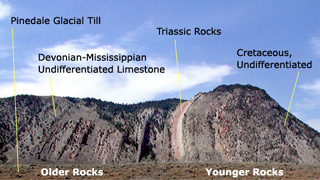
The Devil's Slide
by Linda Lennon
The Devil's Slide ... an ominous name for an interesting and instructive geologic feature. In fact, there are outcrops of this name in many western states. The Hayden Expedition, in 1871, described two such outcrops in their travels. The two described formations have similarities, yet they are located in different states and consist of different rock types. How can these similarities and differences coexist in numerous formations of the same name?
| To understand this type of geologic feature, one needs to understand several of the basic concepts of geology. First of all, sedimentary rocks are deposited, usually by water, in a layer cake fashion, younger strata on top of older strata. There are many different depositional environments that result in many different types of rock. Some examples of rock types deposited in this fashion include sandstone, shale, and limestone. Volcanic rocks can also be deposited in layers, or they can be "injected" between layers of previously deposited rocks.. |  |
Devil's Slide, Paradise Valley, MT Photo by Linda Lennon. |
After deposition, the movement of tectonic plates can deform the layers of rock. There are three different types of motion between plates; convergence, which pushes the plates together, divergence, which pulls the plates apart, and transform motion, in which the plates slide past each other. (Usually, plate motion is a combination of either compression or tension and strike slip motion, which results in an oblique sense of motion.) Deformation resulting from plate movements is usually most visible at plate boundaries, but the resulting strain can also produce deformation far from the actual boundary of the plates. This is the case with the Devil's Slide near Yellowstone National Park; it was formed thousands of kilometers inboard of the site of North America's collision with the converging Kula Plate.
The Devil's Slide near Yellowstone Park occurs in overturned Paleozoic and Mesozoic aged layers of rock. The rock layers involved in the outcrop consist of sandstones and shale. These sedimentary rocks were deposited in layer cake fashion from approximately 250 to 150 million years ago.
 |
Subsequent deformation that resulted from plate convergence occurred in pulses that began at the very end of the Cretaceous Period, approximately 66 million years ago, and lasted approximately 15 million years. The result of this mountain building event was to compress, and eventually completely overturn the rock layers involved. Once the formations were exposed at the surface, erosional processes took over. Since shale is "softer" than most other types of rock, it erodes faster. This differential erosion rate resulted in the shale wearing away much more quickly than the two strata that surround it. |
Diagram by Erik Koehler. |
The red color of the shale that forms the "slide" in the formation occurs as a result of a small percentage of oxidized iron in the rock. Many Triassic aged rocks, all around the world, have this red color. Some geologists believe that the Triassic atmosphere contained more oxygen than previous and present ages, and for this reason the iron present was oxidized. Oxidized iron in very small percentages colors any rock in which it is found a distinctive red.
Voila! The Devil's Slide that we see today, north of the Gardiner Entrance to Yellowstone National Park (and others which developed in a similar but not quite identical manner), is the result of millions of years of deposition, deformation and erosion. It is a potent visual example of many geological processes at work. Continue to the next page, Fossil? Artifact? or Geofact?.
Back to Geology Home Page.